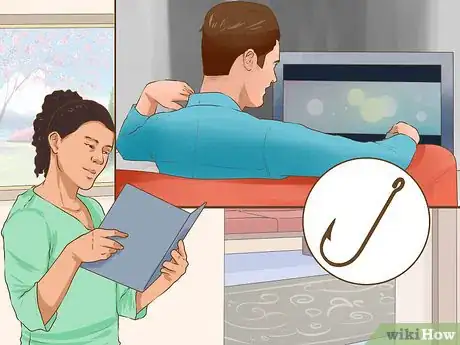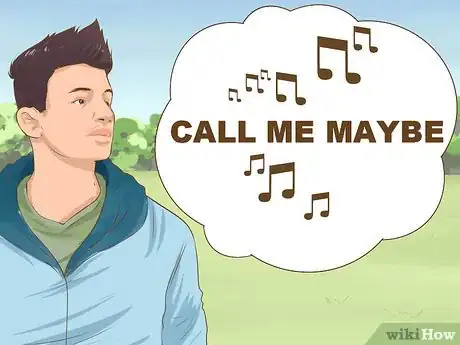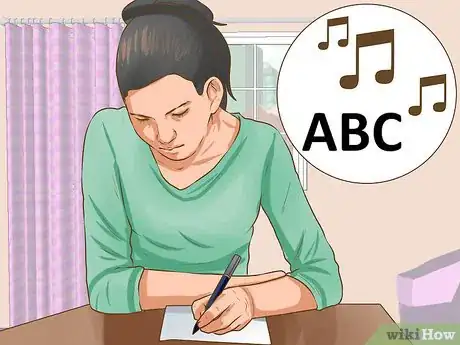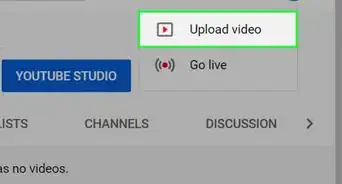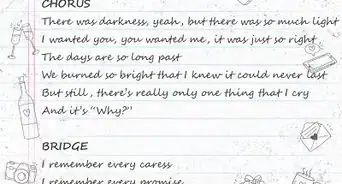This article was co-authored by Tanisha Hall. Tanisha Hall is a Vocal Coach and the Founder and Executive Director of White Hall Arts Academy, Inc. an organization based in Los Angeles, California that offers a multi-level curriculum focused on fundamental skills, technique, composition, theory, artistry, and performance at a conservatory level. Ms. Hall's current and previous students include Galimatias, Sanai Victoria, Ant Clemons, and Paloma Ford. She earned a BA in Music from the Berklee College of Music in 1998 and was a recipient of the Music Business Management Achievement Award.
There are 13 references cited in this article, which can be found at the bottom of the page.
This article has been viewed 71,575 times.
We are all familiar with those catchy songs that seem to get stuck inside our heads. Scientists call these kinds of songs “earworms” and there are many elements that make them so catchy. [1] Here’s how you can try to create your own earworm.
Steps
Writing Lyrics
-
1Choose your subject matter. Begin by asking: what do you feel inspired to write a song about? The most popular songs often have emotional content that is relatable and that resonates with the listeners' own experiences.
-
2Write an interesting first line. The first line is important because it introduces the subject you are writing about and establishes the mood of the song.[2]
- It can also be an effective way of grabbing listeners' attention from the very first instance.
- For example, Gloria Gaynor's hit "I Will Survive" starts with the line: "At first I was afraid, I was petrified," which piques our interest the first time we hear it.[3] We are left wanting to hear how the story will develop throughout the song.
Advertisement -
3Come up with a strong lyrical “hook.” Those in the music industry often stress the importance of an infectious "hook" to capture the audience's attention and draw them into the song. A hook is that magic combination of lyrics, melody and rhythm in a particular section of the song that makes it so appealing to listeners. In terms of lyrics, it refers to a memorable phrase that is repeated throughout the song. It is often found in the chorus, but not always.[4]
- When writing your hook, listen for interesting phrases that pop up in every day life or in popular culture. Look at books, novels, films, slang, television programs for inspiration.[5]
- Focus on emotion. A good hook should capture the emotional emphasis of the song. Make sure all the other lyrics in the song relate to it.
- Build a foundation for the hook through the verses so that when it arrives, there is a sense of tension and release.[6]
-
4Brainstorm to come up with more lyrics. Starting with a lyrical phrase that forms your hook, try brainstorming or doing word association exercises to come up with potential lyrics.
- Write the hook in the middle of a page and write down further words and phrases that relate to it.
- Free association. In this exercise, you relax your mind and don't try to actively think of polished lyrics. Instead, simply list the things that come into your mind when you think about the hook. It might seem pointless but if you look back over what you have written, you may find it contains some good phrases that you can use in your song lyrics.[7]
-
5Keep the lyrics simple and easy to remember. Musicologists have noticed that most popular catchy songs have a smaller number of words in them and feature simple lyrics.[8]
- For example, children's songs and nursery rhymes which feature very few lyrics are frequently cited as archetypal catchy "earworm" songs. Think about Barney's "I Love You, You Love Me" as an example![9]
- You probably don't want to write a nursery rhyme per se, but the same principle applies. The most memorable lyrics are emotive, straight to the point, and contain simple language that can be understood by a mass audience. Carly Rae Jepsen's "Call Me Maybe" is a good example of a song with a simple lyrical hook.
-
6Write more than you need, and pick the best bits. After you have a hook or a chorus and couple of verses you have a pretty much complete first draft of a song. However, it is a good idea to keep writing to see if you can come up with something better than you already have. Then you can edit the lyrics down by picking out the very best lines to use in your song.[10]
Writing the Melody
-
1Use a familiar chord progression. Most popular songs are based on particular chord progressions, which underscore and intersect with the vocal melody. [11]
- Many modern pop and rock songs use the same four chord progression, referred to in Roman numerals as I-V-vi-IV.[12] Examples of songs using this progression include U2's "With or Without You" and The Beatles "Let It Be."[13]
- While common chord progressions are important, you'll need to add something unexpected to make the next hit. Musicologists argue that it is the mix of the familiar and the unexpected that gives particular songs that "earworm" effect.[14]
-
2Come up with a melodic hook. Similar in principle to the lyrical hook, the melodic hook is usually located in the chorus of the song. It should be the catchiest part of the song.
- Catchy melodies are not that easy to come by, you will probably have to try a few before you get one that feels right. Try to mess around with the notes and see what you come up with.
- Make the hook stand out by giving it a slightly different musical structure to the rest of the song. If it stands out it is more likely to stick in the listener's memory.
-
3Synthesize the vocal melody and lyrics. Make sure that your melody and lyrics fit together well. Think about rhythm, timing, subject matter and the general atmosphere of the song.
- Matching the mood of the lyrics and the melody is important. Most catchy songs feature upbeat melodies but there are also beautiful melancholy melodies that capture people's attention.
- Don't shoehorn your lyrics into the melody awkwardly. Both may need to be adapted slightly to achieve the right balance.
Completing and Finessing your Song
-
1Consider the song structure. Most popular songs follow an ABABCB song structure, where A is the verse, B is the chorus and C is the bridge.[15] This structure is familiar and is easier for listeners to remember.
-
2Repeat the hook often. To make a song stick in people's heads, repetition is key. If you have a catchy hook with a winning combination of lyrics and melody, repeat it several times throughout the song.
- The hook may only constitute a five second fragment but that can be all it takes to get your song to stick in people's heads.
-
3Focus on achieving high production quality. Production quality is important, and high production quality will make a song more appealing to the mass market.
- Invest in or borrow the necessary equipment. For example, a microphone and good quality musical instruments and amps are the minimum requirements.
- Most popular music on the radio is produced using digital audio workstation software like ProTools or Ableton.[16] [17] While these programs are often expensive to buy, they also make it possible for many to achieve high quality song production without access to a professional studio.[18]
Community Q&A
-
QuestionIs the hook the same as the chorus?
 Community AnswerNot necessarily. The hook is a musical phrase that catches the listener's ear and draws them in. It can be the chorus or part of the chorus, but doesn't have to be.
Community AnswerNot necessarily. The hook is a musical phrase that catches the listener's ear and draws them in. It can be the chorus or part of the chorus, but doesn't have to be. -
QuestionHow can I figure out the music?
 Community AnswerMake up a melody, and sing while playing it.
Community AnswerMake up a melody, and sing while playing it. -
QuestionCan I still do this when I can't read sheet music?
 Community AnswerYou sure can. Just have an audio recorder of some sort nearby while playing.
Community AnswerYou sure can. Just have an audio recorder of some sort nearby while playing.
References
- ↑ http://www.theatlantic.com/health/archive/2014/01/why-songs-get-stuck-in-your-head/282997/
- ↑ http://www.soundonsound.com/sos/dec00/articles/lyric.asp
- ↑ https://play.google.com/music/preview/Tjm7pjnppa73m76rcj7whlxvgrq?lyrics=1&utm_source=google&utm_medium=search&utm_campaign=lyrics&pcampaignid=kp-lyrics&u=0#
- ↑ http://www.npr.org/sections/therecord/2010/10/15/130588663/you-ask-we-answer-what-s-a-hook
- ↑ http://www.soundonsound.com/sos/dec00/articles/lyric.asp
- ↑ http://www.bmi.com/news/entry/4_dos_and_donts_when_writing_songs
- ↑ Tanisha Hall. Vocal Coach. Expert Interview. 27 March 2020.
- ↑ http://www.uc.edu/news/kellaris.htm
- ↑ http://www.uc.edu/news/kellaris.htm
- ↑ http://www.soundonsound.com/sos/dec00/articles/lyric.asp
- ↑ http://www.guitarworld.com/acoustic-nation-write-stuff-chord-progressions-get-you-started
- ↑ https://en.wikipedia.org/wiki/I%E2%80%93V%E2%80%93vi%E2%80%93IV_progression
- ↑ http://www.guitarworld.com/acoustic-nation-write-stuff-chord-progressions-get-you-started
- ↑ http://news.psu.edu/story/141354/2006/06/05/research/probing-question-what-makes-song-catchy
- ↑ http://blog.sonicbids.com/how-to-write-songs-that-get-stuck-in-peoples-heads
- ↑ https://en.wikipedia.org/wiki/Digital_audio_workstation
- ↑ http://www.digitalmusicnews.com/2014/06/19/popular-digital-audio-workstations-world/
- ↑ http://blog.sonicbids.com/how-to-write-songs-that-get-stuck-in-peoples-heads


